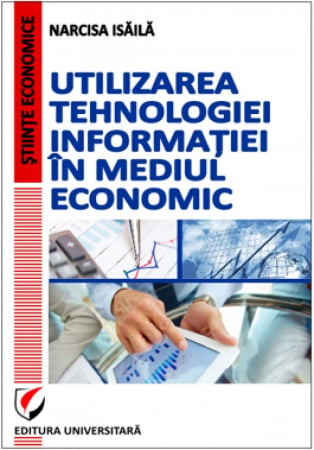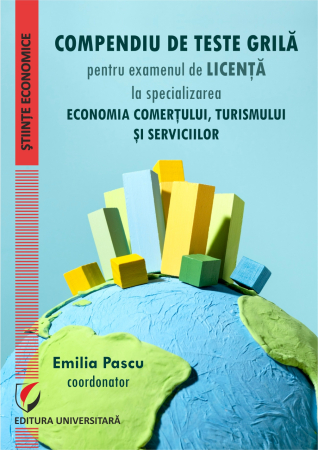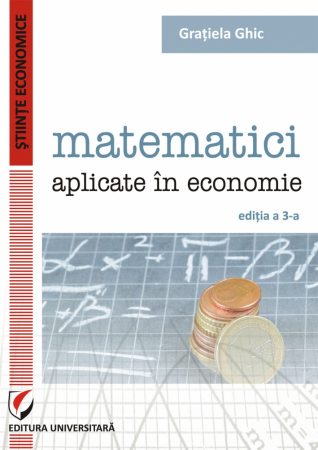Manuscript proposals: [email protected] / 0745 204 115 //// Tracking orders Individuals / Sales: 0745 200 357 / Orders Legal entities: 0721 722 783
6359.png) Set: Economic-Financial Analysis. Theoretical and Practical Landmarks + Economic-Financial Analysis. Grid Tests, VI th edition
Set: Economic-Financial Analysis. Theoretical and Practical Landmarks + Economic-Financial Analysis. Grid Tests, VI th edition
6359.png)
Publisher: Editura Universitară
Author: Gratiela Ghic, Carmen Judith Poenaru-Grigorescu
ISBN: 978-606-28-0143-4, 978-606-28-0144-1
DOI: 10.5682/ 9786062801434, 10.5682/9786062801441
Publisher year: 2015
Edition: a VI-a, revizuita si adaugita
Pages: 328, 290
Product Code:
9786062801434
Do you need help?
0745 200 357
- Description
- Download (2)
- Authors
- Content
- More details
- Reviews (0)
The economic-financial analysis offers the conceptual as well as the methodological-applicative framework of the identification and use of human, material and financial resources through which aspects of the production and commercial activity can be highlighted, the management of the internal potential of the enterprise, costs, profitability, analysis of the financial-patrimonial situation, etc. issues of special interest for practical activity.
The presented paper is addressed to students from economic faculties, specialists from economic units, managers, as well as external users.
The presented paper is addressed to students from economic faculties, specialists from economic units, managers, as well as external users.
GRATIELA GHIC
Ph.D. in Economics, Associate Professor in the Faculty of International Relations of Dimitrie Cantemir Christian University in Bucharest.
Areas of competence: Mathematical modeling business processes, financial mathematics, operations research, economic and financial analysis.
CARMEN JUDITH POENARU-GRIGORESCU
Areas of competence: Mathematical modeling business processes, financial mathematics, operations research, economic and financial analysis.
CARMEN JUDITH POENARU-GRIGORESCU
Economic-Financial Analysis. Theoretical and Practical Landmarks
FOREWORD / 5
TABLE OF CONTENTS / 7
CHAPTER I. OBJECT AND METHOD OF ECONOMIC-FINANCIAL ANALYSIS / 15
1.1. The object of the economic-financial analysis / 15
1.2. Typology of economic-financial analysis / 15
1.3. Analysis functions / 19
1.4. Factors that determine state changes in the functioning of microeconomic systems / 20
1.5. The content of the process of scientific knowledge of the economic-financial phenomena / 22
1.6. The information system, the premise of performing the economic-financial analysis / 24
1.7. The methodology of the economic-financial analysis of the company / 25
1.7.1. Methods of qualitative analysis / 26
1.7.1.1. Basic methods / 26
1.7.1.2. Complementary methods / 27
1.7.2. Methods of quantitative analysis / 28
1.7.2.1. Chain substitution method / 28
1.7.2.2. Balance method / 32
1.7.2.3. Method ABC / 33
1.7.2.4. Rate method / 33
1.7.2.5. Regression analysis method / 34
1.7.2.6. Scoring method / 37
1.7.2.7. Operational Research Method / 38
1.7.2.8. Marginal calculation method / 47
1.7.2.9. Benchmarking / 74
CHAPTER II. ANALYSIS OF THE EXTERNAL ECONOMIC ENVIRONMENT OF THE COMPANY / 77
2.1. Market share analysis / 78
2.2. Competitive position analysis / 80
2.3. Analysis of the competitive structure / 82
2.4. Competitive context analysis / 85
2.5. Models of strategic analysis on the competitive environment / 86
2.5.1. The B.C.G. / 87
2.5.2. ABC (General Electric-McKinsey) Strategic Analysis Model / 91
2.5.3. Model ADL / 94
CHAPTER III. FINANCIAL BALANCE ANALYSIS / 96
3.1. Theoretical approaches / 96
3.2. Balance sheet analysis (financial balance sheet analysis) / 97
3.3. Functional balance analysis (functional balance analysis) / 107
3.4. Economic balance sheet / 109
3.5. Statement of changes in equity / 109
CHAPTER IV. PROFIT AND LOSS ACCOUNT AND FINANCIAL PERFORMANCE OF THE ENTERPRISE / 112
4.1. Presentation of the profit and loss account / 112
4.2. Financial management indicators obtained from the analysis of the income statement / 118
4.3. Self-financing capacity analysis (CAF) / 126
4.4. Analysis of the profitability threshold of an enterprise and of the safety interval / 129
CHAPTER V. DYNAMIC ANALYSIS OF THE FINANCIAL BALANCE / 133
5.1. Financing table “NEEDS - RESOURCES” / 134
5.1.1. Balance sheet - financing table / 135
5.1.2. Profit and loss account relationship - financing table / 136
5.2. Representation and content of the financing table / 139
5.2.1. Analysis of the variation of the global net working capital (DFRNG) / 140
5.2.2. The variation of the working capital requirement and its incidence on the treasury / 144
5.3. Cash flow statement / 146
CHAPTER VI. ANALYSIS OF THE ENTERPRISE ACTIVITY / 151
6.1. Turnover speeds by turnover / 151
6.2. Kinetic rate system / 153
6.3. The normative method for predicting the financial balance / 157
CHAPTER VII. ANALYSIS OF PRODUCTION AND MARKETING ACTIVITY / 160
7.1. Analysis of production and marketing activity, based on value indicators / 160
7.1.1. Analysis of the static ratio between the main value indicators / 162
7.1.2. Analysis of the dynamic ratio between value indicators / 162
7.2. Turnover analysis / 163
7.2.1. Structural analysis of turnover / 165
7.2.2. Factor analysis of turnover / 167
7.3. Value added analysis / 171
7.3.1. Analysis of the dynamics and structure of added value / 173
7.3.2. Factorial analysis of added value / 174
7.4. Analysis of physical production / 179
7.5. Production quality analysis / 185
CHAPTER VIII. ANALYSIS OF ENTERPRISE EXPENSES / 187
8.1. Analysis of expenses related to company revenues / 190
8.2. Analysis of operating expenses / 191
8.3. Analysis of expenses per 1000 lei turnover / 191
8.4. Analysis of variable and fixed expenses / 203
8.4.1. Analysis of variable expenses / 203
8.4.2. Analysis of fixed expenses / 204
8.5. Analysis of the main categories of expenses / 205
8.5.1. Analysis of material expenses / 205
8.5.2. Analysis of depreciation of fixed assets / 208
8.5.3. Analysis of staff costs (salaries) / 211
8.5.3.1. Analysis of the general situation of personnel expenses / 211
8.5.3.2. Analysis of the absolute change of the salary fund / 212
8.5.3.3. Analysis of the correlations of expenses with salaries / 214
8.6. Analysis of financial expenses / 216
8.7. Analysis of the costs related to the production of comparable goods / 222
CHAPTER IX. PROFITABILITY AND RISK DIAGNOSIS / 227
9.1. Profitability diagnosis / 228
9.1.1. Margin rates / 228
9.1.2. Turnover rates and capital structure rates / 231
9.1.3. Capital return rates / 231
9.1.4. Breakdown of rates of return on capital (du Pont system) / 235
9.1.5. Weighted average return on enterprise capital / 236
9.2. Enterprise risk diagnosis / 237
9.2.1. Economic risk (gross profit sensitivity) / 238
9.2.2. Financial risk / 240
9.2.3. Total or combined risk analysis (net profit sensitivity) / 241
9.2.4. Bankruptcy risk (insolvency and lack of liquidity) / 242
9.2.5. Synthetic assessment of bankruptcy risk by the score method / 247
CHAPTER X. PROFITABILITY ANALYSIS / 249
10.1. General considerations regarding profitability / 249
10.2. Profit analysis - as an indicator in absolute size of the company's profitability / 251
10.2.1. Analysis of the general situation regarding the profit of the enterprise / 251
10.2.2. Structural and factorial analysis of the net and gross profit from the total activity of the enterprise / 253
10.2.2.1. Structural and factorial analysis of the net profit from the total activity of the enterprise / 253
10.2.2.2. Structural and factorial analysis of the gross profit from the total activity / 254
10.2.3. Structural and factorial analysis of gross profit at the level of the three types of activities / 255
10.2.4. Factorial analysis of the gross profit related to the total sold production of the enterprise / 259
10.2.5. Factorial analysis of the gross profit related to the sold production of the enterprise at product level / 265
10.3. Methods for calculating and analyzing the rate of return based on the balance sheet and the profit and loss account / 267
10.3.1. Economic profitability rate / 267
10.3.2. Rate of financial profitability or profitability / 274
10.3.3. Rate of return on resources consumed / 276
10.3.4. Analysis of the rate of return on advanced or occupied resources / 279
10.3.5. Structural and factorial analysis of gross profitability by types of activities / 283
10.3.6. Factorial analysis of gross profitability related to total production sold / 284
10.3.7. Factorial analysis of the gross rate of return related to the production sold per product / 286
CHAPTER XI. ANALYSIS OF PRODUCTION FACTORS (HUMAN RESOURCES, FIXED MEANS, RAW MATERIALS AND MATERIALS) / 288
11.1. Analysis of the general situation of labor productivity based on partial value indicators / 288
11.2. Analysis of production volume as an effect of efficient use of human resources / 291
11.3. Analysis of fixed assets management / 294
11.3.1. Analysis of the efficiency of the use of fixed assets / 294
11.3.2. Analysis of production volume as an effect of extensive and intensive use of equipment / 295
11.4. Analysis of physical production as an effect of the efficient use of current assets / 297
CHAPTER XI. HUMAN RESOURCES MANAGEMENT ANALYSIS / 300
12.1. Analysis of the degree of insurance with personnel from a quantitative, structural and qualitative point of view / 301
12.2. Analysis of the degree of insurance with the staff from a quantitative point of view / 301
12.3. Analysis of the degree of insurance with personnel from a structural point of view / 306
12.4. Analysis of the degree of insurance with personnel from a qualitative point of view / 307
12.5. Staff stability analysis / 309
12.6. Analysis of the use of working time / 313
12.7. Analysis of the efficiency of staff use / 317
12.7.1. Analysis of human resources efficiency based on labor productivity / 318
12.7.2. Analysis of the efficiency of human resources use based on the profit per employee / 324
BIBLIOGRAPHY / 325
Economic-Financial Analysis. Grid Tests
FOREWORD / 5
TABLE OF CONTENTS / 7
SOLVED GRIDS / 9
GRIDS PROPOSED FOR RESOLUTION / 159
VERIFICATION TESTS / 230
BIBLIOGRAPHY / 321
FOREWORD / 5
TABLE OF CONTENTS / 7
CHAPTER I. OBJECT AND METHOD OF ECONOMIC-FINANCIAL ANALYSIS / 15
1.1. The object of the economic-financial analysis / 15
1.2. Typology of economic-financial analysis / 15
1.3. Analysis functions / 19
1.4. Factors that determine state changes in the functioning of microeconomic systems / 20
1.5. The content of the process of scientific knowledge of the economic-financial phenomena / 22
1.6. The information system, the premise of performing the economic-financial analysis / 24
1.7. The methodology of the economic-financial analysis of the company / 25
1.7.1. Methods of qualitative analysis / 26
1.7.1.1. Basic methods / 26
1.7.1.2. Complementary methods / 27
1.7.2. Methods of quantitative analysis / 28
1.7.2.1. Chain substitution method / 28
1.7.2.2. Balance method / 32
1.7.2.3. Method ABC / 33
1.7.2.4. Rate method / 33
1.7.2.5. Regression analysis method / 34
1.7.2.6. Scoring method / 37
1.7.2.7. Operational Research Method / 38
1.7.2.8. Marginal calculation method / 47
1.7.2.9. Benchmarking / 74
CHAPTER II. ANALYSIS OF THE EXTERNAL ECONOMIC ENVIRONMENT OF THE COMPANY / 77
2.1. Market share analysis / 78
2.2. Competitive position analysis / 80
2.3. Analysis of the competitive structure / 82
2.4. Competitive context analysis / 85
2.5. Models of strategic analysis on the competitive environment / 86
2.5.1. The B.C.G. / 87
2.5.2. ABC (General Electric-McKinsey) Strategic Analysis Model / 91
2.5.3. Model ADL / 94
CHAPTER III. FINANCIAL BALANCE ANALYSIS / 96
3.1. Theoretical approaches / 96
3.2. Balance sheet analysis (financial balance sheet analysis) / 97
3.3. Functional balance analysis (functional balance analysis) / 107
3.4. Economic balance sheet / 109
3.5. Statement of changes in equity / 109
CHAPTER IV. PROFIT AND LOSS ACCOUNT AND FINANCIAL PERFORMANCE OF THE ENTERPRISE / 112
4.1. Presentation of the profit and loss account / 112
4.2. Financial management indicators obtained from the analysis of the income statement / 118
4.3. Self-financing capacity analysis (CAF) / 126
4.4. Analysis of the profitability threshold of an enterprise and of the safety interval / 129
CHAPTER V. DYNAMIC ANALYSIS OF THE FINANCIAL BALANCE / 133
5.1. Financing table “NEEDS - RESOURCES” / 134
5.1.1. Balance sheet - financing table / 135
5.1.2. Profit and loss account relationship - financing table / 136
5.2. Representation and content of the financing table / 139
5.2.1. Analysis of the variation of the global net working capital (DFRNG) / 140
5.2.2. The variation of the working capital requirement and its incidence on the treasury / 144
5.3. Cash flow statement / 146
CHAPTER VI. ANALYSIS OF THE ENTERPRISE ACTIVITY / 151
6.1. Turnover speeds by turnover / 151
6.2. Kinetic rate system / 153
6.3. The normative method for predicting the financial balance / 157
CHAPTER VII. ANALYSIS OF PRODUCTION AND MARKETING ACTIVITY / 160
7.1. Analysis of production and marketing activity, based on value indicators / 160
7.1.1. Analysis of the static ratio between the main value indicators / 162
7.1.2. Analysis of the dynamic ratio between value indicators / 162
7.2. Turnover analysis / 163
7.2.1. Structural analysis of turnover / 165
7.2.2. Factor analysis of turnover / 167
7.3. Value added analysis / 171
7.3.1. Analysis of the dynamics and structure of added value / 173
7.3.2. Factorial analysis of added value / 174
7.4. Analysis of physical production / 179
7.5. Production quality analysis / 185
CHAPTER VIII. ANALYSIS OF ENTERPRISE EXPENSES / 187
8.1. Analysis of expenses related to company revenues / 190
8.2. Analysis of operating expenses / 191
8.3. Analysis of expenses per 1000 lei turnover / 191
8.4. Analysis of variable and fixed expenses / 203
8.4.1. Analysis of variable expenses / 203
8.4.2. Analysis of fixed expenses / 204
8.5. Analysis of the main categories of expenses / 205
8.5.1. Analysis of material expenses / 205
8.5.2. Analysis of depreciation of fixed assets / 208
8.5.3. Analysis of staff costs (salaries) / 211
8.5.3.1. Analysis of the general situation of personnel expenses / 211
8.5.3.2. Analysis of the absolute change of the salary fund / 212
8.5.3.3. Analysis of the correlations of expenses with salaries / 214
8.6. Analysis of financial expenses / 216
8.7. Analysis of the costs related to the production of comparable goods / 222
CHAPTER IX. PROFITABILITY AND RISK DIAGNOSIS / 227
9.1. Profitability diagnosis / 228
9.1.1. Margin rates / 228
9.1.2. Turnover rates and capital structure rates / 231
9.1.3. Capital return rates / 231
9.1.4. Breakdown of rates of return on capital (du Pont system) / 235
9.1.5. Weighted average return on enterprise capital / 236
9.2. Enterprise risk diagnosis / 237
9.2.1. Economic risk (gross profit sensitivity) / 238
9.2.2. Financial risk / 240
9.2.3. Total or combined risk analysis (net profit sensitivity) / 241
9.2.4. Bankruptcy risk (insolvency and lack of liquidity) / 242
9.2.5. Synthetic assessment of bankruptcy risk by the score method / 247
CHAPTER X. PROFITABILITY ANALYSIS / 249
10.1. General considerations regarding profitability / 249
10.2. Profit analysis - as an indicator in absolute size of the company's profitability / 251
10.2.1. Analysis of the general situation regarding the profit of the enterprise / 251
10.2.2. Structural and factorial analysis of the net and gross profit from the total activity of the enterprise / 253
10.2.2.1. Structural and factorial analysis of the net profit from the total activity of the enterprise / 253
10.2.2.2. Structural and factorial analysis of the gross profit from the total activity / 254
10.2.3. Structural and factorial analysis of gross profit at the level of the three types of activities / 255
10.2.4. Factorial analysis of the gross profit related to the total sold production of the enterprise / 259
10.2.5. Factorial analysis of the gross profit related to the sold production of the enterprise at product level / 265
10.3. Methods for calculating and analyzing the rate of return based on the balance sheet and the profit and loss account / 267
10.3.1. Economic profitability rate / 267
10.3.2. Rate of financial profitability or profitability / 274
10.3.3. Rate of return on resources consumed / 276
10.3.4. Analysis of the rate of return on advanced or occupied resources / 279
10.3.5. Structural and factorial analysis of gross profitability by types of activities / 283
10.3.6. Factorial analysis of gross profitability related to total production sold / 284
10.3.7. Factorial analysis of the gross rate of return related to the production sold per product / 286
CHAPTER XI. ANALYSIS OF PRODUCTION FACTORS (HUMAN RESOURCES, FIXED MEANS, RAW MATERIALS AND MATERIALS) / 288
11.1. Analysis of the general situation of labor productivity based on partial value indicators / 288
11.2. Analysis of production volume as an effect of efficient use of human resources / 291
11.3. Analysis of fixed assets management / 294
11.3.1. Analysis of the efficiency of the use of fixed assets / 294
11.3.2. Analysis of production volume as an effect of extensive and intensive use of equipment / 295
11.4. Analysis of physical production as an effect of the efficient use of current assets / 297
CHAPTER XI. HUMAN RESOURCES MANAGEMENT ANALYSIS / 300
12.1. Analysis of the degree of insurance with personnel from a quantitative, structural and qualitative point of view / 301
12.2. Analysis of the degree of insurance with the staff from a quantitative point of view / 301
12.3. Analysis of the degree of insurance with personnel from a structural point of view / 306
12.4. Analysis of the degree of insurance with personnel from a qualitative point of view / 307
12.5. Staff stability analysis / 309
12.6. Analysis of the use of working time / 313
12.7. Analysis of the efficiency of staff use / 317
12.7.1. Analysis of human resources efficiency based on labor productivity / 318
12.7.2. Analysis of the efficiency of human resources use based on the profit per employee / 324
BIBLIOGRAPHY / 325
Economic-Financial Analysis. Grid Tests
FOREWORD / 5
TABLE OF CONTENTS / 7
SOLVED GRIDS / 9
GRIDS PROPOSED FOR RESOLUTION / 159
VERIFICATION TESTS / 230
BIBLIOGRAPHY / 321
Economic-Financial Analysis. Theoretical and Practical Landmarks
The paper addresses issues of economic and financial analysis encountered at the microeconomic level both theoretically and practically, being an excellent support for those who enter the "secrets" of this discipline or those who they want to explore this science.
This paper has a methodological character emphasizing theories, concepts, principles and models of economic and financial analysis.
The structure of the book allows the understanding and gradual assimilation of the presented knowledge, as the first part of it offers explanations regarding the calculation of the main economic-financial indicators found in the analysis models used in the second part of the book, which makes the learning process much easier.
Analytical - on the specifics of "case studies" and having as object of investigation a series of economic-financial indicators used in practical activity - were designed the application sequences inserted in each chapter of the paper, insisting on the systemic side of diagnosis and regulation corresponding to the various situations found.
The economic-financial analysis offers the conceptual as well as the methodological-applicative framework of the identification and use of human, material and financial resources through which aspects of the production and commercial activity, the management of the internal potential of the enterprise, costs, profitability, analysis of the financial-patrimonial situation can be highlighted. , etc. issues of special interest for practical activity.
The presented paper is addressed to students from economic faculties, specialists from economic units, managers, as well as external users.
We thank in advance the students and specialists who will come with observations and new suggestions on the content of the paper so that, at the next edition, it will appear improved.
At the end of these lines, our grateful thoughts are directed to those who put their soul in the training of many specialists in the area of economic and financial analysis and who offered us generous support in all our professional endeavors: Prof. univ. dr. Constantin Stanescu, Prof. univ. Dr. Constantin C. Cojocaru.
The Authors
Economic-Financial Analysis. Grid Tests
The present paper has an applicative character, constituting a completion of the course “Economic-financial analysis. Theoretical and practical landmarks ”, which contains 160 grid-type applications, solved by the author and 200 applications proposed for solving.
This paper offers the possibility to the one who goes through the solved applications and then the proposed ones, to fix his acquired knowledge based on the theoretical course, regarding the various aspects of the analysis of financial balance, analysis of enterprise performance, analysis of financial situation, profitability, costs, and so on
The paper is intended for all students who are preparing in this vast field of economic-financial analysis or anyone who wants to benefit from the practical knowledge of this discipline.
In order to improve the content of a future edition, we express our full availability for comments and suggestions from readers.
The Authors
The paper addresses issues of economic and financial analysis encountered at the microeconomic level both theoretically and practically, being an excellent support for those who enter the "secrets" of this discipline or those who they want to explore this science.
This paper has a methodological character emphasizing theories, concepts, principles and models of economic and financial analysis.
The structure of the book allows the understanding and gradual assimilation of the presented knowledge, as the first part of it offers explanations regarding the calculation of the main economic-financial indicators found in the analysis models used in the second part of the book, which makes the learning process much easier.
Analytical - on the specifics of "case studies" and having as object of investigation a series of economic-financial indicators used in practical activity - were designed the application sequences inserted in each chapter of the paper, insisting on the systemic side of diagnosis and regulation corresponding to the various situations found.
The economic-financial analysis offers the conceptual as well as the methodological-applicative framework of the identification and use of human, material and financial resources through which aspects of the production and commercial activity, the management of the internal potential of the enterprise, costs, profitability, analysis of the financial-patrimonial situation can be highlighted. , etc. issues of special interest for practical activity.
The presented paper is addressed to students from economic faculties, specialists from economic units, managers, as well as external users.
We thank in advance the students and specialists who will come with observations and new suggestions on the content of the paper so that, at the next edition, it will appear improved.
At the end of these lines, our grateful thoughts are directed to those who put their soul in the training of many specialists in the area of economic and financial analysis and who offered us generous support in all our professional endeavors: Prof. univ. dr. Constantin Stanescu, Prof. univ. Dr. Constantin C. Cojocaru.
The Authors
Economic-Financial Analysis. Grid Tests
The present paper has an applicative character, constituting a completion of the course “Economic-financial analysis. Theoretical and practical landmarks ”, which contains 160 grid-type applications, solved by the author and 200 applications proposed for solving.
This paper offers the possibility to the one who goes through the solved applications and then the proposed ones, to fix his acquired knowledge based on the theoretical course, regarding the various aspects of the analysis of financial balance, analysis of enterprise performance, analysis of financial situation, profitability, costs, and so on
The paper is intended for all students who are preparing in this vast field of economic-financial analysis or anyone who wants to benefit from the practical knowledge of this discipline.
In order to improve the content of a future edition, we express our full availability for comments and suggestions from readers.
The Authors
If you want to express your opinion about this product you can add a review.
write a review

![Set: Economic-Financial Analysis. Theoretical and Practical Landmarks + Economic-Financial Analysis. Grid Tests, VI th edition [1] Set: Economic-Financial Analysis. Theoretical and Practical Landmarks + Economic-Financial Analysis. Grid Tests, VI th edition [1]](https://gomagcdn.ro/domains/editurauniversitara.ro/files/product/large/set-economic-financial-analysis-theoretical-and-practical-landmarks-economic-financial-analysis-grid-tests-ed-vi-688-2877.png)














